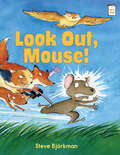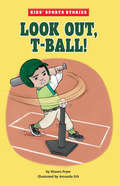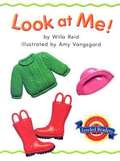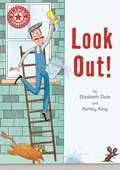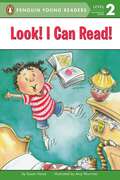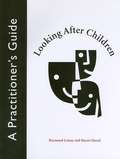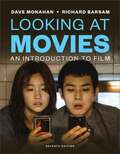- Table View
- List View
Look Out, Mouse! (I Like to Read)
by Steve BjörkmanThe chickens are enjoying their feed, the dog is eagerly emptying his bowl—but Farmer Fred forgot to feed the horse. But Mouse will help, in this Guided Reading Level E story! Mouse nibbles at the bag of oats so Horse can get his dinner, too—until Cat chases him away. Look out, Mouse! Cat is soon joined by Owl and Snake, and Mouse has nowhere to run. . . . until grateful Horse starts a noisy riot that gets Farmer Fred to open the door. Look out, house! It's time for Mouse's dinner. Perfect for kindergarten and early first grade students to read on their own, Look Out, Mouse! features a simple text with lots of repetition and patterns, supported by Steve Bjorkman's lively, detailed illustrations. This farm is full of laughs—and a reminder that sometimes, lending someone a hand will help you both in the end. The award-winning I Like to Read® series focuses on guided reading levels A through G, based upon Fountas and Pinnell standards. Acclaimed author-illustrators--including winners of Caldecott, Theodor Seuss Geisel, and Coretta Scott King honors—create original, high quality illustrations that support comprehension of simple text and are fun for kids to read with parents, teachers, or on their own! Level E stories feature a distinct beginning, middle, and end, with kid-friendly illustrations offering clues for more challenging sentences. Varied punctuation and simple contractions may be included. Level E books are suitable for early first graders. When Level E is mastered, follow up with Level F.
Look Out, T-Ball! (Kids' Sports Stories)
by Shawn PryorMarlon knows he's not the best player on his T-ball team, but he can't understand why he's striking out at the sport, especially when he tries so hard. Teammate Anna offers to practice with him and soon sees why Marlon can't focus.
Look Up: The Fun of Spotting Planes (Fountas & Pinnell Classroom, Guided Reading Grade 3)
by Carmen MoraisNIMAC-sourced textbook
Look Who's Talking: The Art of Ventriloquism (Fountas & Pinnell Classroom, Guided Reading)
by Amanda YskampNIMAC-sourced textbook. A Ventriloquist's Secrets Revealed. Watching a ventriloquism act is like watching a person perform a magical feat with a puppet as a partner. The audience laughs in wonder at the puppet's funny jokes as the puppet's sidekick—a real person—manipulates its mouth and body parts. Some puppets sing, some tell jokes, and others try to do magic tricks. They seem so lifelike the audience wonders how on earth the puppets can talk. Find out the secrets from a real ventriloquist, Rey Ortega, and share a good laugh with his entertaining puppets.
Look at This! (Into Reading, Level B)
by Lisa Trumbauer<p>NIMAC-sourced textbook <p>Look for animals and a boy around trees. Are they in a tree, under a tree, over a tree, or elsewhere?</p>
Look at Us (Journeys Grade K Little Big Book Unit 6 #Book 29)
by F. Isabel CampoyNIMAC-sourced textbook
Look out!: Independent Reading Red 2 (Reading Champion #94)
by Elizabeth DaleIn this story, Ted is up his ladder cleaning windows when a mouse scampers past, followed by a cat, followed by a dog, followed by a boy - uh oh, look out Ted!Reading Champion is a book banded reading programme for independent reading offering fantastic, original stories accompanied by engaging artwork. Each book has been carefully levelled making it easy to match to a child's reading ability and fully supports reading for pleasure.
Look! I Can Read! (Penguin Young Readers, Level 2)
by Susan HoodA little girl proudly shows off her reading skills as she spends a day out on the town with her mom. Children are sure to be delighted as they read along with the narrator in ths fun, rhyming, easy-to-read story.
Look-Alike Animals
by Robin BernardExplains the differences between such animal look-alikes as cheetahs and leopards, frogs and toads, crocodiles and alligators, seals and sea lions, and rabbits and hares.
Looking After Children: A Practitioner's Guide
by Hayat Ghazal Raymond LemayLooking After Children is an assessment and planning approach for children and youth in out-of-home care, first developed in the UK, and since 1997 adapted and used increasingly in Canada, particularly in Ontario. The approach is developmental and strengths based. The Assessment and Action Record (AAR), the core clinical tool, provides the basis for an in-depth assessment interview which then leads to a comprehensive care plan. The AAR is computerized and provides the possibility of data aggregation, and the recent revision allows for comparability among Canadian children as assessed by the National Longitudinal Survey of Children and Youth. Looking After Children: A Practitioner's Guide includes training material that will help practitioners understand and put the LAC approach and tools to effective use.
Looking Out, Looking In: Activities Manual and Study Guide (MindTap Course List)
by Ronald B. Adler Russell F. Proctor Jimmie ManningLearn how to master and apply strong communication principles in both your personal relationships and on the job with Adler/Proctor/Manning's popular LOOKING OUT, LOOKING IN, 16E. Written with you in mind, this market-leading book connects today's latest research and theories to your everyday life. This is a textbook you'll actually enjoy reading with current, captivating magazine-style readings and the latest pop culture references -- from recent Marvel movies to viral stars rising through TikTok. This edition continues to focus on the impact of social media and technology on relationships, whether it's "Netflix and chill" or families tethered to cell phones during dinner. You explore the lives of diverse people as you gain a wide sense of understanding about relationships. Compelling photos and cartoons, thought-provoking prompts and hands-on activities bring principles to life. MindTap digital resources are also available to reinforce learning.
Looking at Light
by Karen A. FrenkelFind out about the properties of light energy by investigating the color spectrum, reflection, and refraction.
Looking at Movies: An Introduction to Film
by Richard Barsam Dave MonahanStudents love watching movies. Give them the tools to understand why. <p><p>Building on students’ enthusiasm for screened entertainment, Looking at Movies is more successful than any other text at motivating students to understand and analyze what they see onscreen. The Seventh Edition features new and refreshed video, assessment, and interactive media, making the book’s pathbreaking media program more assignable and gradable than ever before. Looking at Movies gives instructors all they need to inspire students to graduate from passive watching to active looking.
Looking at Snowflakes (Fountas & Pinnell Classroom, Guided Reading Grade 4)
by Lara AndersonNIMAC-sourced textbook
